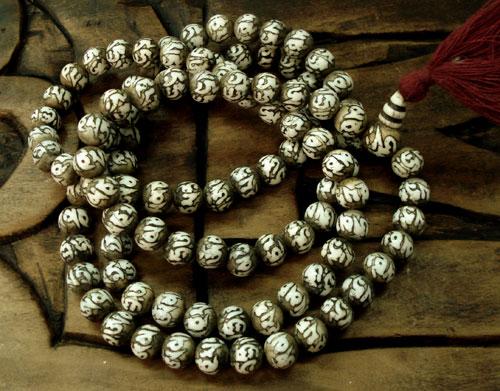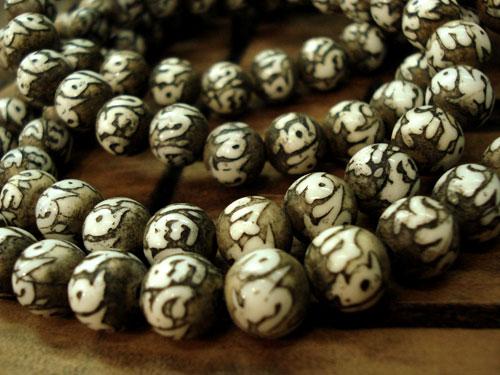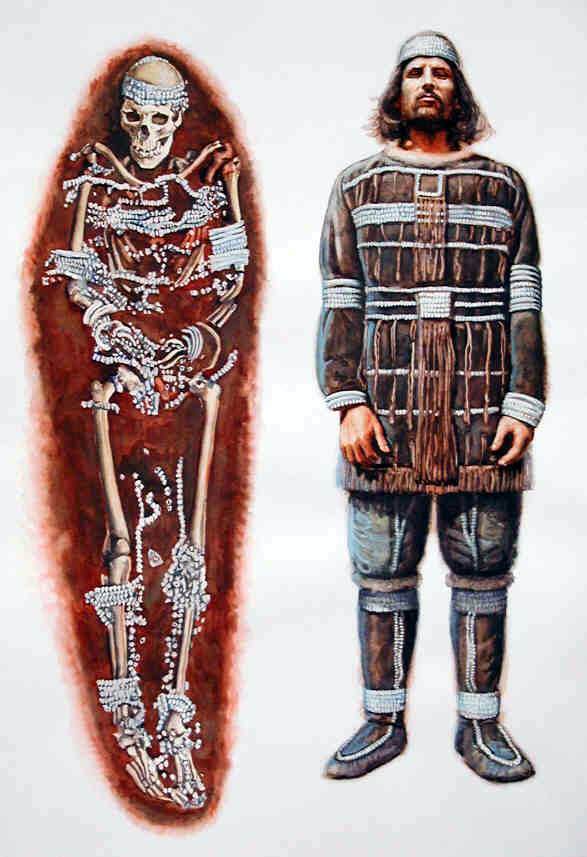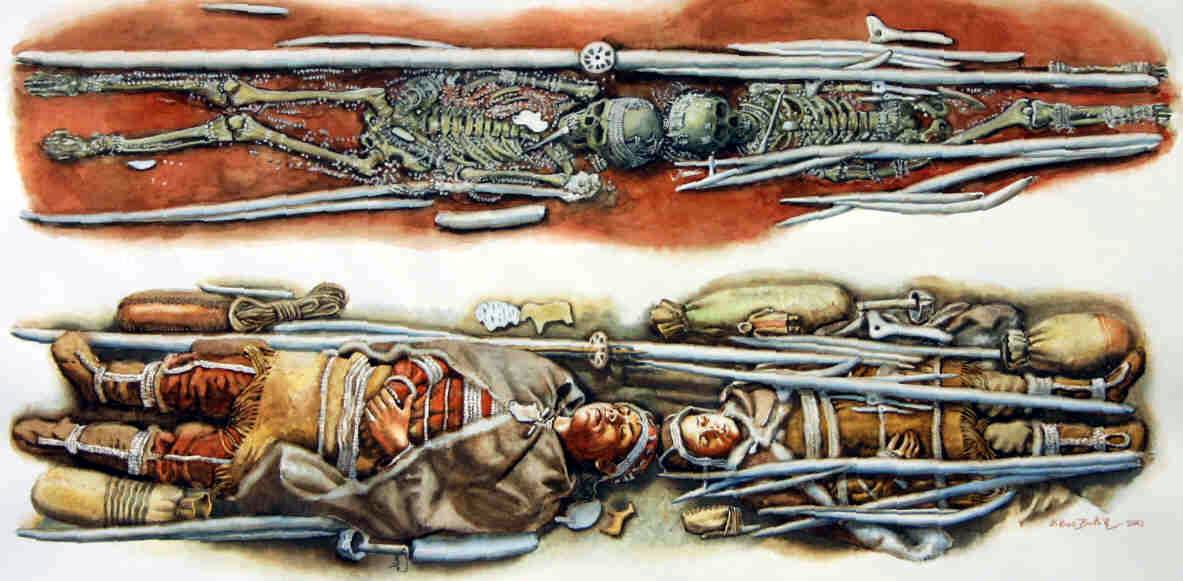In the previous section(Part D) of our article on the “Neanderthal”Man, we mentioned that the “Cro-Magnon”Man was the first human being to create a “culture”, using our general definition of culture which translates into”…the beliefs, way of life, art, and customs that are shared and accepted by people in a particular society…”.The social pre-requisites needed to create an “organized culture” are many, some we have already specified when we described the everyday patterns of life, the everyday human behavior, the everyday social habits and the social organization of the groups of Cro-Magnon humans; that “human specie” which established itself throughout Europe, coming from the Middle East and North Africa more than 45,000 years ago. I believe that it is vital for us to outline once again, some of the human parameters which permitted the Cro-Magnons to create the first “organized society” and the first “organized culture” in their “primitive form”.
The basic “human ingredients” or “capacities” which were utilized creatively and effectively by the Cro-Magnons, materializing in a viable social organization and culture were four .First, there was “abstract thinking”, based on concepts which go beyond specific examples. “Abstract thinking” can produce voice sounds with a certain “practical application” which in time develop into sets of complex sounds and the basic “building blocks” of “language communication”. The second human capability that was used by the Cro-Magnons in a very constructive way was the human mental potential of “planning” for what has to be achieved at a future time point. In practical terms this could be translated into the construction of solid permanent winter shelters which could last for many years, withstanding the extreme forces of nature of that time(Glacial Period).Similarly, there was storage of dried fish for everyday food consumption, when animal prey was scarce. Third, there is once again a human mental procedure which today we may call it the “dialectic mental process” whose central focus is “innovation”; finding a better solution for a practical problem by utilizing past experience and experimentation. Innovations can be found in all aspects of life, from tools and weapons to a pision of labor , and from the quality of shelters to hunting strategies. Finally, we have the “symbolic human behavior” which is directly related to images, rituals, even prescribed human roles which can reinforce the cohesion, the identity and the continuity of a “social group” through “time and space”.Such “symbolic human behavior” can be seen in the “complex painted caves”, sacred locations for member initiation, burial sites in show of respect for the “departed member” and for the “after-life”, and last, we have the “shaman” or the “guide” of the group whose “out of the ordinary” attire and body ornaments reflect his unique position in the group as a “mediator” between the “metaphysical” or the “heavenly powers” and “mortal human existence (p. 2. http://www.newworldencyclopedia.org/entry/Cro-Magnon).
In order for these human “ingredients” or “capacities” to be active and “in full force”, the inpidual within the group had to feel as an “indispensable”, “unique” and “dynamic” unit of the whole. A social unit whose feelings of “altruism” and “empathy” for all the other members , as well as for members of other Cro-Magnon groups, would formulate the “ideal social environment” where active human communication, creative human imagination and practical human thinking could achieve their highest potential.”…The era during which the Cro-Magnons lived must have been one filled with busy work and excitement. They were always on the move, searching for food, new tools, and more efficient ways of life….They were a civilized group of humans who used the best of their knowledge in order to make the many advancements for their time…”(p.2.http://cas.bellarmine.edu/tietjen/Human %20Nature%20S%201999/a…).
An essential “existential condition” for a group of human beings like the Cro-Magnons to create the first “social organization” and the first “human culture” was first to ensure steady food supplies which could provide them with at least a subsistence level of food consumption and also to construct and maintain solid shelters which would protect them physically from the extreme weather conditions which they had been experiencing for thousands of years. This they did very effectively and efficiently as we have already described in the previous section(Part D) of our article, contrary to what had occurred with the Neanderthals and had to slowly “leave the human scene”. There is plenty of sound evidence which shows that the Cro-Magnons rarely struggled to fight starvation(p.1.http:// cas.bellarmine.edu/tietjen/Human%20Nature%20S%201999/a…). Yet, what provided this “human specie” with the tools to formulate the “first human culture” was its “sensitivity” and “mental ability” to transform the “metaphysical” and the “abstract” into creative social components. These social components had a direct positive impact on the “social cohesion” of the Cro-Magnon groups, which in turn produced those social mechanisms which would allow them as inpiduals to withstand and rationalize their everyday insecurities derived either from basic material necessities or from inner fears of the unknown(forces of nature, mortality, infinity of the universe). For the Cro-Magnons the ideal way to translate and metamorphose the “abstract metaphysical” into something concrete, was through art in general, whether in cave paintings, in complex burial sites, in small hand made statues, in delicate beads, in musical instruments or even in ritualistic group ceremonies “inspired” and “guided” by a “shaman”, the “spokesperson” of the Spirit World.”…Archeologists believe that this creativity “was central to their experience of their environment and to the way they explained the world(Tattersall 1998).” When the Cro-Magnons were going through difficult times and life’s necessities were scarce, they may have believed that producing artwork would help to improve their hunting success and heal those stricken by hunger and illness…”(p.2.http://bellarmine.edu/tietjen/Human%20Nature%20S%201999/a…).
There is solid evidence which shows that “cooperation” and “sharing”(altruism, empathy) characterized the everyday behavior of the Cro-Magnons, otherwise they would not have been able to construct complex permanent shelters which in some cases housed a large number of inpiduals (p.1. http://www.cartage.org.lb/en/themes/Sciences/ LifeScience/Physical A…). Similarly, they would not have been such efficient hunters and food gatherers, ensuring good health and longer cycles of life, going well beyond adulthood. Archeologists and anthropologists discovered specific evidence in Cro-Magnon living quarters which demonstrates the sense of “cooperation” and “sharing” which existed among this “specie” of human beings, contrary to what had been occurring in the everyday lives of the Neanderthals. Both the Neanderthals and the Cro-Magnons caught fish to supplement their food diets, but only in Cro-Magnon camp sites fish bones were found, which means that the Cro-Magnons brought back the fish they had caught to be shared by all, while the Neanderthals ate the fish “on the spot”. Another more dramatic example reveals not only that there was sharing and cooperation among the members of a Cro-Magnon group, but that this sharing and cooperation also occurred between different Cro-Magnon groups which lived close to each other.”…Dramatic evidence for such sharing comes from one locality in France, where archeologists have identified the remains of a single animal distributed between three different campfire sites separated by hundreds of feet and presumably occupied by different families…”(p.2.http://www.human-nature.com/ darwin/books/tattersall.html). In sharing and cooperation there is not only a “pragmatic component” which becomes more evident in the long run( increasing the chances of group survival and development by harmonizing all human abilities and talents), but there is also an “emotional” one. For the Cro-Magnons, this “emotional component”( intimacy, affinity, erotic attraction, complemented personalities) which many species share with us , was refined, reinforced and institutionalized through “art”, starting from their aesthetic creations and ending in their complex and phantasmagoric rituals. This is the basic reason why “Cro-Magnon”Man is considered the enlightened creator of the “first human culture”. “…Their cultural artifacts suggest a highly developed emotional sense, and a desire to share these concepts and stories with others. This would clearly facilitate the formation of social structures and emotional ties within the community…” (p.1-2. http://serendip.brynmawr.edu/sci_cult/evolit/s05/web1/rbaglini.html).
For anthropologists and archeologists alike, the Cro-Magnon burial sites have come to represent rich sources of information concerning almost every aspect of the life of this “human specie”. Different societal components such as their aesthetics in art and construction, their sense of time and space, especially within the context of metaphysics, and finally the incentives the Cro-Magnons formulated for themselves in order to create this refined and perse cultural reality. We know that occasionally, the Neanderthals “took the time” and “made the effort” to simply bury their dead , using very simple and simplistic procedures. There is therefore no solid evidence that they fathomed the enormity of this existential event(death) to their own group as a whole(social affinity towards a specific member) or to a personal human interpretation of a finite “human cycle” within an infinite universe( time and space). With the Cro-Magnon burial sites, we observe a complete transformation in the way the “human specie” comprehends the ” meaning” and the “aesthetics” of an inpidual’s mortal existence. The fact that the construction of burial sites are well designed and regular(geometrical pattern), and also that the inpiduals who are buried are placed in specific positions and are adorned with handcrafted ornaments, demonstrates not only great respect for the deceased person but for “mortal life”, as there is universal recognition of an “after-life”. Second, the fact that there are “grave goods” buried with the deceased, suggests that there must have been institutionalized ritualistic procedures which took place, and also that there was a “social consensus” and “social participation”. Third, through this complex social ritual of human burial where the social group participates directly or indirectly, shows that the inpiduals in this social group were mentally conscious of the “spaces of time”, having a sense of the “lapse of time” which they could manifest it in an “abstract way”, by “respecting the old” and by “lamenting the dead”. They could also utilize this human sense of time in a pragmatic way by organizing their seasonal group migrations, their hunting and food gathering patterns and their short run and long run priorities and goals. For the Cro-Magnons it wasn’t only a question of survival but also an expectation for a better quality of life , where there would be leisure time for entertainment and aesthetic creativity. There is evidence from artifacts found by scientists that at a certain point in their evolution (25,000 years ago), the Cro-Magnons developed a type of “lunar calendar”(Fig.1) which helped them practically to recognize the cyclical nature of the seasons.”…They are also the first to show signs of cognitive thinking and planning ahead. They created a type of lunar calendar in order to keep track of the seasonal herd movements. They also developed a method of curing and storing meat throughout the cold winters by digging holes in the permafrost and using it like a deep freezer…”(p.2. http://cas.bellarmine.edu./tietjen/Human%20Nature%20S%201999/a…)
 |
| Fig.1 |
The Cro-Magnons were in reality the first jewelry makers in human evolution , and most of this jewelry has been found in their graves since they decorated their dead with elaborate ornaments, The jewelry was made from mother- of-pearl, stone, bones, teeth and mammoth tusks. The bracelets and the necklaces found on the Cro-Magnon skeletons were strung onto pieces of string or animal sinew(p.1.http://jewelry fashionz.com/).
 |
 |
| Fig.2 | Fig.3 |
These refined body ornaments found in graves, not only indicate the sophistication of Cro-Magnon craftsmanship and their refined everyday aesthetics, but they also manifest two very critical “existential factors”. The first is that the members of the Cro-Magnon groups put great “artistic effort” and “emotion” to make their dead “attractive” for their journey to an “after-life” , but even more critical was the fact that they had ensured the necessary living conditions(food surpluses) so as to be able to spend long periods of time in creating such delicate objects. A very good example in understanding these two last points related to the life-style of the Cro-Magnons is the Cro-Magnon burial site which was recently discovered by archeologists in the Sungir region of Russia, and which they calculated to be approximately 28,000 years old.”…Two young inpiduals and a sixty-year-old male(no previous kind of human had ever survived to such an age) were interred with an astonishing material richness. Each of the deceased was dressed in clothing onto which more than three thousand ivory beads had been sewn; and experiments have shown that each bead had taken an hour to make. They also wore carved pendants, bracelets, and shell necklaces. The juveniles, buried head to head, were flanked by two mammoth tusks over two yards long…” (p.4.http://www.human-nature.com/Darwin/books/tattersall.html).
 |
 |
| Fig.4 | Fig.5 |
In the next section of our article, we shall continue to describe the “aesthetic” and “emotional” elements in the everyday lives of the Cro-Magnons, trying to clarify their “symbolic” and “metaphysical” significance within the “first human culture”, while also putting great emphasis on the “protagonist” of this “creative human miracle” who was the “shaman”, the “inspiration” and the “guiding light” of this really “intelligent human specie”!!!
